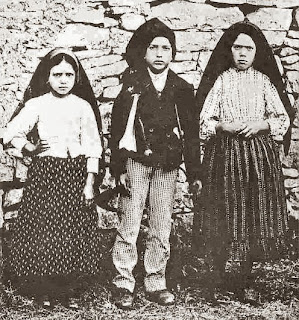Today is the feast day of Our Lady of Fatima, commemorating the first apparition of the Blessed Lady in White to three peasant children in Fatima, Portugal 96 years ago. In four more years, it will be the 100th anniversary of the apparitions. Despite the psycho-babble over the years which has attempted to explain the whole phenomenon in terms of psychological repression and projection on the part of the eldest child, Lucy dos Santos, there is something deeply moving about this whole story - inexplicable, mysterious, holy. The story of the children's lives is one of suffering, trials and contradictions, endless contradictions, which one wouldn't wish on any child.
Pope Francis received the original Fatima stature into St. Peter's Square last evening, followed by prayers and a vigil. This Sunday morning, he celebrated Mass in St Peter's Square before a large crowd of faithful and devout "Marianists," to coin a word. It was a moving experience to witness Pope Francis' evident deep devotion to Mary in her Fatima manifestation. However, to be honest, I found it so disconcerting to witness the preponderance of male clerics dominating the services, no women priests apparent anywhere (of course). But at this point in history, it is such a jarring vision to see, and tends to mar the ceremonies.
Blue Eyed Ennis has some wonderful links to videos of the events at her very spiritual blog.
I am also a devotee of Fatima, despite the numerous signs of contradiction surrounding these phenomena. Every corrupt Portuguese dictator has felt compelled pro forma to sink to his knees before the same stature that so moved the Holy Father last evening. Right wring groups of every shade and persuasion have appropriated the legend for their own uses, thereby alienating more liberal Christians who shun such manifestations of religious fanaticism. And homophobia, in particular, is rampant and virulent among Fatima devotees, to a very alarming extent. This alone should give pause to any gay Christians. Yet, I continue to discern Our Blessed Mother's true presence here, calling all of us, across all ideological lines, to a life of penance, prayer and sacrifice. And I believe she calls persons of my own orientation and persuasion precisely to make the point that her apparitions are not to be appropriated by any extremist faction, however loudly they proclaim their ownership. Fatima is holy and sacred, the children reached heights of loving sacrifice that were astonishing, and Sister Lucy lived to nearly 90, both blind and deaf before her passing in 'the odor of sanctity'. There is a mystery here that defies explanation, whatever the human element may be.
The apparitions of
Garabandal, Spain (remember those) in the 1960's have been long eclipsed by its more flamboyant and famous younger sister, Medjugorje in Bosnia. Yet Garabandal has been linked to Fatima, and some are predicting that the long awaited consummation of Garabandal will take place in 2017, on the 100th anniversary of Fatima. I was profoundly moved by the Garabandal story while in the Sacred Heart Jesuit Novitiate in Los Gatos , California. I have remained among the small, loyal remnant who - 48 years later - are still waiting for Garabandal's moment to arrive. One of the original visionaries has passed on, one has 'defected' and denied the apparitions, The two other visionaries, now in their sixties, remain faithful and patient, living ordinary married lives, with children and grandchildren. Like Fatima and Medjugorje, the call is the same, prayer, prayer and more prayer, penance, sacrifice and prayer, and great devotion to the Holy Eucharist. There is little that is controversial or partisan about the messages of these appearances. Yet it remains a mystery why 'the conservative right' rushes to own them with disconcerting noise and fanfare, while the more liberal part of the church finds the whole phenomenon distasteful. That is a generalization, of course, but fairly accurate on the whole. I remain one of the strange exceptions, but while we are few, we are not alone. Two summers ago, during the 30th anniversary of the apparitions at Medjugorje (another shrine surrounded by contradictions), I sat next to two very progressive nuns from a liberated order. Their habits consisted of long skirts with a beautiful, colorful weave, white flowing silken long sleeved blouses, simple wooden crosses around their necks, no head coverings, and long, flowing grey hair, gracefully coifed down their backs. Their very appearance bespoke dedicated spiritual women, who valued their own feminine natures and beauty and were in no way espousing the traditional ascetic image of self denial of most religious sisters. We got into a conversation, I told them I was a gay Catholic living on the edge, and they responded simply and warmly. One of them told me with deep sympathy about the gay issue, "The Church does change, slowly, very slowly, but change does come." She gave me such a warm, understanding smile. Gracious, intelligent, liberated, progressive - and here they were honoring Our Lady at the shrine of Medjugorje in Bosnia Herzogovina. Mary is calling many of us of a similar outlook and orientation to journey to her shrines, to honor her, to receive her call and her graces, and to witness to others that such a call is not in contradiction to our own most cherished values and principles. Mary is for all, and the call to prayer, penance and sacrifice can be embraced by all of us from one end of the spectrum to the other in this sacred family called church. Let us not let one end of the spectrum so dominate the conversation that the simple grace and beauty of Mary's call becomes confused with the cacophony of human ego.















